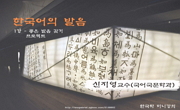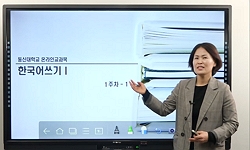언어 교육에 있어서 실질적인 의사소통 능력의 신장은 가장 중요한 목표라 할 수 있다. 최근 언어 교육학의 동향은 이러한 의사소통 능력을 기르기 위해 효과적인 방법들을 제안해 오고 있...
http://chineseinput.net/에서 pinyin(병음)방식으로 중국어를 변환할 수 있습니다.
변환된 중국어를 복사하여 사용하시면 됩니다.
- 中文 을 입력하시려면 zhongwen을 입력하시고 space를누르시면됩니다.
- 北京 을 입력하시려면 beijing을 입력하시고 space를 누르시면 됩니다.
초급 한국어 교육의 소그룹 활동에 대한 연구 = (A) study on Using Small-Group Work to Teach Korean as a Foreign Language to beginners
한글로보기https://www.riss.kr/link?id=T7110801
- 저자
-
발행사항
서울 : 이화여자대학교 대학원, 1998
-
학위논문사항
학위논문(석사) -- 이화여자대학교 대학원 , 한국학과 , 1998. 8
-
발행연도
1998
-
작성언어
한국어
- 주제어
-
KDC
710.7 판사항(4)
-
발행국(도시)
서울
-
형태사항
vi, 103p. ; 26cm
-
일반주기명
참고문헌: p. 88-93
- 소장기관
-
0
상세조회 -
0
다운로드
부가정보
국문 초록 (Abstract)
본고는 소그룹 활동에 대한 이론적 배경이 미비한 국내 현실을 감안해 우선 소그룹 활동에 대해 개괄적인 정리를 했고, 소그룹 활동이 현재 어느 정도 초급 한국어 수업에 활용되고 있는지를 알아보기 위해, 몇몇 한국어 교육기관의 초급 한국어 수업의 현황 조사와 함께 초급 교재들을 비교분석해 보았으며, 다음으로 소그룹 활동에 대한 교사와 학습자의 의식에 차이가 있는지를 조사하여 실질적인 소그룹 활동을 모색하였다.
그 결과 많은 교사와 학습자들이 소그룹 활동에 대해 그 필요성을 지지하였고, 더 많은 소그룹 활동을 하기를 바라는 것으로 나타났다. 또한 본고는 소그룹 활동을 위한 그루핑 방법, 수행 가능한 과제, 교사의 오류수정 등에 대하여 설문 조사를 하여, 교사가 실제적으로 학습자가 원하는 수업을 할 수 있는 방안을 제시하였다. 그러므로 본고는 소그룹 활동의 활성화를 통한 실질적인 의사소통 능력의 신장으로 효율적인 초급 한국어 수업을 이루는데 지침이 될 수 있다는 점에서 그 의의를 찾을 수 있다.
언어 교육에 있어서 실질적인 의사소통 능력의 신장은 가장 중요한 목표라 할 수 있다. 최근 언어 교육학의 동향은 이러한 의사소통 능력을 기르기 위해 효과적인 방법들을 제안해 오고 있는데, 그 중에서 소그룹 활동을 활용한 방법은 최근의 언어교수 접근법에서 중요한 위치를 차지하고 있다. 그러나 이러한 소그룹 활동을 활용한 한국어 교육은 그다지 많이 이루어지지 않고 있는 듯하다. 그러므로 본고에서는 한국어 교육, 특히 초급 단계에서의 한국어 교육을 위한 효율적인 방안으로서 소그룹 활동의 활용을 제안하려 한다.
본고는 소그룹 활동에 대한 이론적 배경이 미비한 국내 현실을 감안해 우선 소그룹 활동에 대해 개괄적인 정리를 했고, 소그룹 활동이 현재 어느 정도 초급 한국어 수업에 활용되고 있는지를 알아보기 위해, 몇몇 한국어 교육기관의 초급 한국어 수업의 현황 조사와 함께 초급 교재들을 비교분석해 보았으며, 다음으로 소그룹 활동에 대한 교사와 학습자의 의식에 차이가 있는지를 조사하여 실질적인 소그룹 활동을 모색하였다.
그 결과 많은 교사와 학습자들이 소그룹 활동에 대해 그 필요성을 지지하였고, 더 많은 소그룹 활동을 하기를 바라는 것으로 나타났다. 또한 본고는 소그룹 활동을 위한 그루핑 방법, 수행 가능한 과제, 교사의 오류수정 등에 대하여 설문 조사를 하여, 교사가 실제적으로 학습자가 원하는 수업을 할 수 있는 방안을 제시하였다. 그러므로 본고는 소그룹 활동의 활성화를 통한 실질적인 의사소통 능력의 신장으로 효율적인 초급 한국어 수업을 이루는데 지침이 될 수 있다는 점에서 그 의의를 찾을 수 있다.
다국어 초록 (Multilingual Abstract)
Accordingly, this thesis aims to make Korean classes for beginners more dynamic by using small group work. The author gave a survey about small group work in Korean classes for beginners to 44 Korean teachers and 158 foreign students. This survey demonstrated the difference between Korean teachers' ideas about language learning and students' expectations about grouping, various tasks and error correction.
Before giving the survey about small group work, the author interviewed a number of directors and teachers in several Korean language institutions such as Yonsei University, Korea University, Ewha Womans University, ELS(English Language School) and CLI(Central Language Institute) and showed their present methods for using small group work in Korean classes and also showed how their Korean textbooks were organized to facilitate small group work.
The results of the survey demonstrated that a lot of Korean teachers and foreign students want to increase the time for small group work in beginning classes. Korean teachers should consider the needs of students when grouping them in class. Certain conditions, such as students' native language, age, sex and learing ability according to their native language should be considered. The author divided the students into 3 groups; English speakers, Japanese speakers and other language speakers according to their native language. English speakers want to be grouped with people who speak -better Korean than themselves while Japanese speakers want to work in a mixed group of older Japanese students whose Korean is more proficient than their own. Other language speakers want to be grouped with a mixed group of people who are younger and better than themselves at speaking Korean.
The results concerning the tasks assigned during small group work showed that teachers' and students' preferences are similar for role play, games, jigsaw puzzles and interviews. And students requested more error correction from their teachers while they were doing small group work.
In conclusion, the author hopes this data will help many Korean teachers plan more effective small group work for the classroom. And this in turn will help students become more motivated to learn Korean in the classroom.
Developing authentic communication skills has been the most important aim in language education. Small group work is one of the ways to increase student talking time and create a positive affective atmosphere within a language class. Small group work ...
Developing authentic communication skills has been the most important aim in language education. Small group work is one of the ways to increase student talking time and create a positive affective atmosphere within a language class. Small group work in Korean classes, however, is not well organized and has not been used enough to allow students to practice Korean during the class.
Accordingly, this thesis aims to make Korean classes for beginners more dynamic by using small group work. The author gave a survey about small group work in Korean classes for beginners to 44 Korean teachers and 158 foreign students. This survey demonstrated the difference between Korean teachers' ideas about language learning and students' expectations about grouping, various tasks and error correction.
Before giving the survey about small group work, the author interviewed a number of directors and teachers in several Korean language institutions such as Yonsei University, Korea University, Ewha Womans University, ELS(English Language School) and CLI(Central Language Institute) and showed their present methods for using small group work in Korean classes and also showed how their Korean textbooks were organized to facilitate small group work.
The results of the survey demonstrated that a lot of Korean teachers and foreign students want to increase the time for small group work in beginning classes. Korean teachers should consider the needs of students when grouping them in class. Certain conditions, such as students' native language, age, sex and learing ability according to their native language should be considered. The author divided the students into 3 groups; English speakers, Japanese speakers and other language speakers according to their native language. English speakers want to be grouped with people who speak -better Korean than themselves while Japanese speakers want to work in a mixed group of older Japanese students whose Korean is more proficient than their own. Other language speakers want to be grouped with a mixed group of people who are younger and better than themselves at speaking Korean.
The results concerning the tasks assigned during small group work showed that teachers' and students' preferences are similar for role play, games, jigsaw puzzles and interviews. And students requested more error correction from their teachers while they were doing small group work.
In conclusion, the author hopes this data will help many Korean teachers plan more effective small group work for the classroom. And this in turn will help students become more motivated to learn Korean in the classroom.
목차 (Table of Contents)
- 목차 = ⅲ
- 논문개요 = ⅵ
- Ⅰ. 서론 = 1
- A. 연구의 목적 = 1
- B. 연구의 방법 = 4
- 목차 = ⅲ
- 논문개요 = ⅵ
- Ⅰ. 서론 = 1
- A. 연구의 목적 = 1
- B. 연구의 방법 = 4
- C. 외국어 교수법의 최근 경향 = 5
- Ⅱ. 소그룹 활동의 이론적 고찰 = 11
- A. 소그룹의 개념 = 11
- 1. 소그룹 활동을 통한 학습과 대규모, 개인 학습의 비교 = 11
- 2. 소그룹의 범위 = 14
- B. 소그룹 활동의 내용 = 15
- 1. 그루핑(Grouping)의 방법 = 15
- 2. 소그룹 활동의 유형과 단계 = 19
- 3. 소그룹 활동 과제(Task)의 종류 = 23
- 4. 소그룹 활동의 효과 = 28
- 5. 교사의 역할과 평가 = 32
- Ⅲ. 초급 한국어 교육의 현황과 교육 내용 = 36
- A. 초급 한국어 교육의 현황 = 36
- B. 교육기관별 초급 한국어 교재 고찰 = 40
- Ⅳ. 소그룹 활동의 현황과 제안 = 59
- A. 조사 방법 = 59
- B. 조사 1 : 그루핑의 방법 = 61
- C. 조사 2 : 선호하는 과제의 종류와 소그룹 활동의 효과 = 70
- D. 조사 3 : 교사의 한국어 사용률과 오류 수정률 = 76
- E. 제안 = 82
- Ⅴ. 결론 = 85
- 참고문헌 = 88
- 부록 = 94
- ABSTRACT = 102












